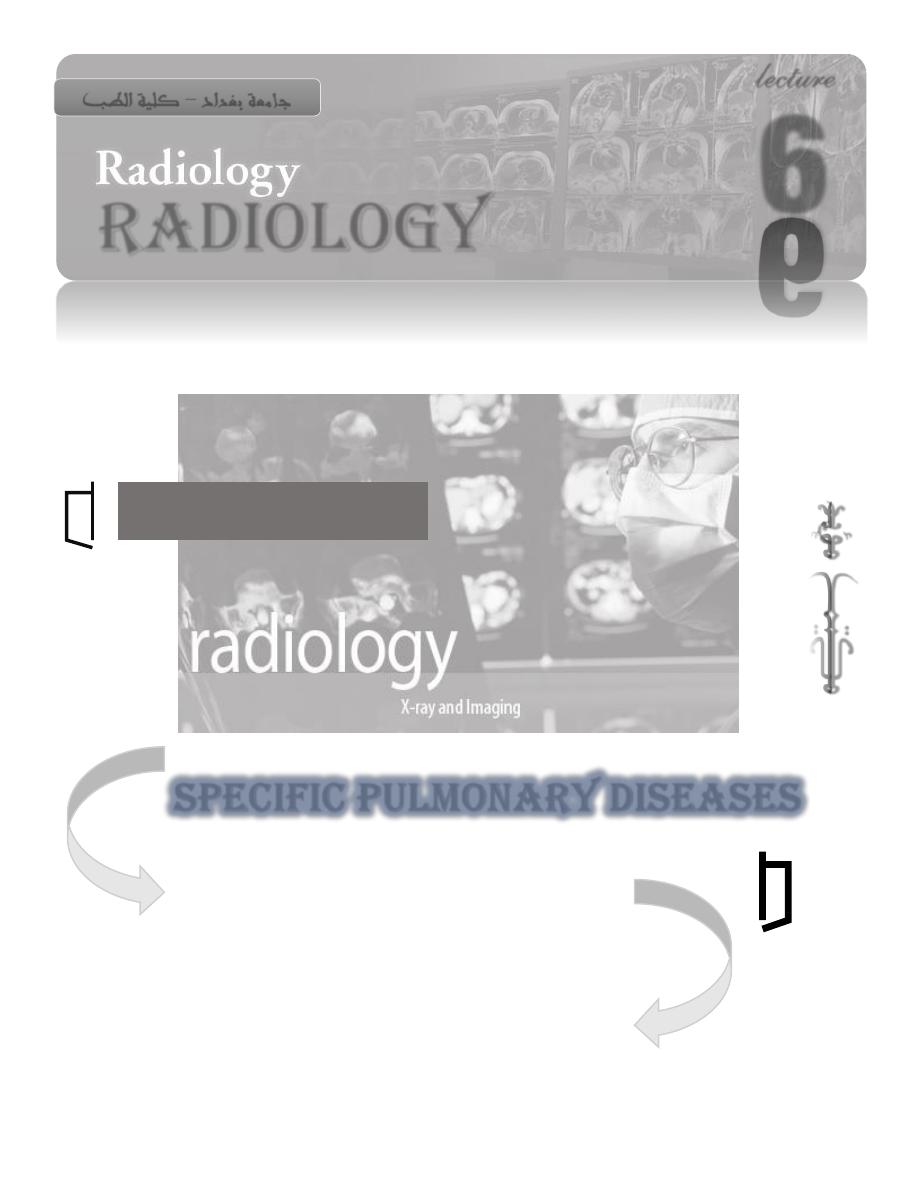
RadioLoGY
lecture
6
جامعة بغداد
–
كلية الطب
Specific pulmonary diseases
ؤيد
م بتكم
MUSTAFA laith
Dr Laith

1
Chest Radiology
Lecture 6 Appendix + Specific Pulmonary Diseases Dr. Laith
Chest Radiology
Imaging Techniques
1. Plain radiograph.
2. Computed tomography CT scan.
Indications of CT scan of the chest:
Suspected hilar or mediastinal LAP.
Staging of tumors.
Mediastinal masses.
Aortic & oesophageal diseases.
Intrathoracic nodules.
Pleural pathology.
Airway diseases e.g. bronchiectasis.
pulmonary embolism.
3. Other techniques:
MRI is used in selected cases of apical pulmonary tumors & in some
mediastinal lesions & intraspinal extent of neural tumors
Radionuclide imaging is used to diagnose pulmonary embolic disease
Positron emission tomography (PET) used to diagnose the malignant
nature of pulmonary nodule, but inflammatory conditions also concentrate
the agent.
US to evaluate cases of pleural effusion & masses & also useful in guiding
aspiration.

2
Chest Radiology
Lecture 6 Appendix + Specific Pulmonary Diseases Dr. Laith
Pulmonary angiography involves injection of contrast medium into the
pulmonary arteries through a catheter introduced from groin or antecubital
fossa. Pulmonary angiography is used to diagnose pulmonary embolic
disease & congenital vascular anomalies.
Bronchography is used previously in cases of bronchiectasis & now is
obsolete.
Fluoroscopy shows the movement of the diaphragm & shift of the
mediastinum in cases of suspected foreign body inhalation.
Plain radiographs:
PA view is the routine film (while AP view is reserved for sick patients). Chest
X-ray (CXR) must be performed with full inspiration & in erect position.
Lateral view may be needed as a supplementary.
Lordotic view is used for apical lesions.
Expiratory view is used to demonstrate diaphragmatic movements, suspected
foreign body inhalation. Pneumothorax may be more obvious on this view.
Technical evaluation of CXR:
1. Correct exposure: so that the spine can be identified through the heart.
2. Good centering: so that the medial ends of the clavicles are equidistant from the
spinous process of the thoracic vertebrae.
3. Full inspiration: so that the dome of the right hemidiaphragm is level with the
anterior end of the 6
th
rib.

3
Chest Radiology
Lecture 6 Appendix + Specific Pulmonary Diseases Dr. Laith
Reading frontal CXR:
CXR must be evaluated in a systematic pattern (e.g. from outside to inside):
Outside the bony thorax (check the chest wall for soft tissue swelling,
subcutaneous emphysema & sub diaphragmatic region).
Check the bones for any fracture, lysis or sclerosis.
Check the diaphragm: the outline of the upper surface must be clear. Both
costophrenic angles must be sharp. Position of the right hemidiaphragm is 1-
3 cm higher than the left.
Check the pulmonary parenchyma (from top to bottom & compare the left
zone with the right zone). The only visible structures in pulmonary
parenchyma are the blood vessels (that decrease in diameter as we trace them
outwards & downwards) & fissures (the minor fissure is noted in the PA
view running horizontally from the right hilum while the oblique fissure is
noted on the lateral view).
Check the mediastinum: *the position of the trachea is central or slightly to
the right. *The position of the heart is usually 1/3 to the right of the midline.
The size of the heart is measured by (cardiothoracic ratio (CTR) <50% & up
to 60% in infants) or (change in the transverse diameter of the heart in serial
films of >1.5 cm). *The lateral borders of the heart & mediastinum must be
clear. *The left hilum is slightly higher than the right hilum & both are of
similar density & size. *In children < 7 years, the thymus may be seen like
anterior mediastinal mass & forms sail outline.

4
Chest Radiology
Lecture 6 Appendix + Specific Pulmonary Diseases Dr. Laith
Reading lateral CXR:
The retrocardiac density must be similar to the retrosternal density.
The vertebral body should appear more lucent than the one above.
There must be no abrupt change in density over the heart.
NB: When any abnormality is found on PA view, decide its location by asking for a
lateral view.
Silhouette sign:
Intrathoracic lesion in contact with the heart, mediastinum or diaphragm will cause
the normal clear border to become ill defined or invisible. This sign is useful for
localization of pulmonary diseases on CXR & on occasion, this sign makes it
possible to diagnose pulmonary diseases (e.g. consolidation).
Loss of the heart border occurs when the lesion lies in the anterior half of the chest,
while loss of the diaphragm border occurs in diseases of the pleura or the lower
pulmonary lobes.
NB: when confronted with abnormal CXR or CT, try to put any abnormal shadows
into one of the following:

5
Chest Radiology
Lecture 6 Appendix + Specific Pulmonary Diseases Dr. Laith
Pulmonary shadows:
1. Air-space disease (replacement of alveolar air by flui or other material)
Consolidation.
Pulmonary oedema.
2. Collapse.
3. Mass.
4. Line shadows.
5. Widespread small shadows.
Consolidation
Ill-defined pulmonary shadow with air bronchograms (occur in pulmonary
edema & pneumonia) & silhouette sign. When become in contact with a
fissure, the shadow will become of well defined border.
Consolidation may be lobar (involve one lobe & this diagnostic of bacterial
pneumonia) or patchy (one or more patches of ill defined shadowing & this
usually occur in infection & may also occur in infarction, contusion &
immunological disorders).
Cavitation within consolidation occurs in staph. Klebsiella, T.B., anaerobic
infections, fungal infection & in infarction & Wegner's granulomatosis.

6
Chest Radiology
Lecture 6 Appendix + Specific Pulmonary Diseases Dr. Laith
Collapse
Ill-defined shadow with signs of volume loss (displacement of fissures, elevation
of diaphragm, elevation of the hilum & tracheal shift) & silhouette sign.
Causes of pulmonary collapse:
1. Bronchial obstruction (*in the wall e.g. bronchial carcinoma. or *intraluminal
e.g. foreign body, mucus plug in post-operative patients. or *invasion or
compression by adjacent mass).
2. Fibrosis will cause displacement of fissures e.g. T.B.
3. Pleural diseases e.g. pleural effusion. The diagnosis is usually obvious.
4. Hyaline membrane disease.
Pulmonary oedema
Causes:
1. Circulatory problems e.g. heart failure or renal failure.
2. Non-cardiogenic problems (ARDS) e.g. as in inhalation of noxious gases,
aspiration of gastric contents.
Alveolar oedema: is always acute & usually bilateral & involves all lobes. The
shadow is greatest close to the hilae (forming Bats wing appearance or Butterfly
appearance).
The most important feature is rapidity with which oedema appears & disappears with
treatment.

7
Chest Radiology
Lecture 6 Appendix + Specific Pulmonary Diseases Dr. Laith
Interstitial oedema: may cause thickening of the fissures, lack of clarity of the blood
vessels & septal lines (Kerley A & B lines). In addition to cardiomegaly & upper lobe
diversion.
NB: Kerley A lines are central, noted in the mid & upper zones & measures 3-6
cm, while Kerley B lines are peripheral & seen at the bases & short lines (1-2 cm).
Solitary pulmonary nodule
Causes: 1. malignant tumors (primary or secondary)
2. Benign tumors (e.g. hamartoma).
3. Granulomas e.g. T.B.
4. Abscess.
5. Metastasis.
6. Round pneumonia.
When a solitary pulmonary nodule is noted, the following points must be assessed:
1. Rate of growth by asking for previous film & comparing the size.
2. Calcification occurs in T.B. granuloma & in hamartoma (popcorn calcification).
CT is more sensitive than CXR in detection of calcification. Benign pattern of
calcification (uniform calcification, ring calcification, popcorn calcification)
exclude bronchial Ca.
3. Adjacent chest wall e.g. rib destruction in Pancoast tumor.

8
Chest Radiology
Lecture 6 Appendix + Specific Pulmonary Diseases Dr. Laith
4. Shape of the border; lobulated, notched or infiltrating speculated border occur in
malignant tumors.
5. Cavitation occurs in abscess or bronchial carcinoma & metastases (in abscess, the
wall of the cavity is of uniform thickness & thinner than cavitating malignancy
where the wall is also non uniform in thickness).
6. Size: if > 4 cm, indicate malignancy, abscess, round pneumonia or hydatid.
7. Pleural effusion, LAP & bony lesions.
8. CT may be indicated for further evaluation of the lesion (regarding its nature &
staging of malignant nodules & for accurate localization).
Multiple pulmonary nodules:
Secondaries.
Multiple abscesses.
Granulomatous diseases e.g. T.B. or sarcoidosis.
Fungal diseases.
Collagen vascular diseases.
Line shadows
Edge of a Pneumothorax.
Scars of previous infection or infarction usually reach the pleural & associated
with visible pleural thickening.
Linear atelactasis due to hypoventilation (in post-op patients, post-traumatic
patients)

9
Chest Radiology
Lecture 6 Appendix + Specific Pulmonary Diseases Dr. Laith
Bullae.
Septal lines.
Multiple ring shadows:
Occur in bronchiectasis.
Multiple small calcified nodules:
Occur in T.B., histoplasmosis & chicken pox.
Increased transradiancy of the lung
Emphysema (causes generalized increase in pulmonary transradiancy). But
compensatory emphysema (in cases of collapse or lobectomy) will cause
localized increase in transradiancy.
Pneumothorax.
Reduction in soft tissues of the chest wall (e.g. mastectomy)
Air trapping.
Reticular +/- nodular shadows
Need to be combined with the history & examination.
Reticulo-nodular shadows will obscure adjacent diaphragmatic & cardiac
borders or make them less distinct.
The distribution of the shadowing (whether peripheral or upper or lower zones)
will aid in the diagnosis.

11
Chest Radiology
Lecture 6 Appendix + Specific Pulmonary Diseases Dr. Laith
Causes:
1. Miliary T.B. uniform distribution +- LAP , consolidation
2. Fibrosing alveolitis basal & peripheral in distribution.
3. Sarcoidosis upper distribution +- LAP.
4. Pneumoconiosis; upper zones +- progressive massive fibrosis.
5. Lymphangitis carcinomatosa +- hilar LAP & signs of Ca.
6. Pulmonary oedema; cardiomegaly, left atrial enlargement.
Lung diseases with normal chest radiograph
Pulmonary embolism without infarction.
COAD e.g. asthma, bronchitis, bronchiectasis.
Infections e.g. early phase of pneumocystis carinii & military T.B.
Small lesion (< 1 cm nodules) & endobronchial lesions.
Diffuse pulmonary diseases (e.g. fibrosis) where dyspneoa present before any
detectable abnormality on CXR.
Pleural diseases e.g. dry pleurisy & small pleural effusions.
Mediastinal masses, LN, fluid collections (CXR is insensitive).

11
Chest Radiology
Lecture 6 Appendix + Specific Pulmonary Diseases Dr. Laith
Specific pulmonary diseases
Pneumonias
The role of CXR in clinically suspected pneumonias is to confirm the diagnosis (in
addition to the bacteriological results) & to look for complications of pneumonia.
Radiologically, bacterial pneumonia will present with
Consolidation: can be lobar, spherical or widespread ill-defined shadows.
Lobar consolidation occur in bacterial (e.g. streptococcal, staphylococcal &
Klebsiella) & mycoplasmal infection.
Patchy consolidation (bronchopneumonia) occurs in staph, gram –ve,
anaerobic infection & mycoplasmal pneumonia.
Spherical consolidation occurs in pneumococcal or Legionnaire's disease.
Widespread ill defined shadows occur in viral or mycoplasmal infection.
Cavitation inside consolidation occur in cases of T.B. , gram –ve , anaerobic
& klebsiella infections.
Pleural effusion & LAP: occur in anaerobic infection, T.B. & fungal infection
& malignant tumors with post-obstructive pneumonia.
Upper lobe consolidation occurs in T.B.
In children, pneumonias may result in atelactasis & air trapping.
Post-obstructive pneumonia (in patients > 35 y due to carcinomas & in children
due to F.B. inhalation) must be suspected when pneumonia confined to one
lobe, associated with volume loss, no air bronchograms & if pneumonia will
not resolve after treatment.

12
Chest Radiology
Lecture 6 Appendix + Specific Pulmonary Diseases Dr. Laith
Viral & mycoplasma pneumonia produce widespread ill defined consolidation
& loss of clarity of vascular markings & sometimes may cause only a localized
consolidation. Pleural effusion is rare. The radiological abnormality may persist
for many weeks after clinical recovery.
Abscess
Can be caused by aspiration, infection beyond obstructing lesion, infected
emboli in drug addicts.
Abscess can be due to staph. , klebsiella or T.B.
Radiologically, abscess will appear as a spherical shadow with a central lucency
+/- air-fluid level. DDX: cavitating neoplasm or Wegner's granulomatosis.
Pulmonary tuberculosis
Primary T.B:
Ghon focus (area of consolidation) in periphery of middle or upper zones.
Hilar or mediastinal LAP.
Ghon focus + LAP= primary complex that heals with calcification & remain
visible throughout life.
Primary T.B. may progress to TB pneumonia (due to spread via bronchial tree)
or miliary shadows (due to hematogeneous spread).

13
Chest Radiology
Lecture 6 Appendix + Specific Pulmonary Diseases Dr. Laith
Post-primary T.B.:
Involves the upper posterior portions of the lungs (apical & posterior segments
of upper lobes & apical segment of the lower lobes). Occasionally, it may take
the form of lower or middle lobe bronchopneumonia.
Multiple small consolidations that increase in size & frequently cavitate.
Heals with fibrosis & calcification.
May resemble lobar pneumonia.
May give rise to miliary TB.
In non-Caucasian, the predominant or sole feature may be LAP.
NB pleural effusion occur frequently in primary & post-primary TB.
Tuberculoma:
Spherical mass < 3 cm with sharp edge & often with calcifications.
It is invariably inactive but viable bacilli may be present deep in the lesion.
Signs of activity:
1. Development of new lesions on serial films.
2. cavity
3. Calcifications will not exclude active disease.
4. To confirm active disease, sputum culture is needed.

14
Chest Radiology
Lecture 6 Appendix + Specific Pulmonary Diseases Dr. Laith
Hydatid disease
Hydatid cyst may affect the lung or the pleural cavity.
Radiologically, hydatid cyst will results in solitary or multiple well-defined
spherical shadows.
Hydatid cyst may rupture resulting in water lily appearance.
Mycetoma
Aspergillus fumigatus may colonize cavities e.g. TB cavity & produce a ball of
fungus (mycetoma), so air is seen between mycetoma & the wall of cavity & these
cavities are usually surrounded by evidence of old TB (fibrosis & calcification).
Pleural thickening is noted adjacent to these cavities.
Pneumonia in immunocompromised host
May result in atypical radiographic appearances. Pneumonia may be due unusual
pathogens e.g. candida albicans, aspergilllus, TB, pneumocystis carinii.
Radiological appearances:
1. Similar to pneumonia in competent patient (in standard pathogens).
2. Widespread nonspecific pulmonary shadowing (in opportunistic infection).

15
Chest Radiology
Lecture 6 Appendix + Specific Pulmonary Diseases Dr. Laith
Differential diagnosis of pulmonary shadowing in AIDS:
1. Pneumocystis carinii.
2. TB.
3. pulmonary edema
4. pulmonary hemorrhage
5. Kaposi's sarcoma.
Pulmonary embolism
CXR:
Is insensitive for diagnosis of pulmonary embolism & is usually normal.
The radiographic findings are nonspecific.
The role of CXR is to exclude clinically similar diseases e.g. Pneumothorax &
dissecting aneurysm.
The radiographic signs are:
1. Enlargement of major arterial trunk at the hilum.
2. Discoid atelactasis (indicating poor diaphragmatic excursion).
3. Elevation of hemidiaphragm.
4. Wedge shape consolidation based on pleura +- ipsilateral pleural effusion.

16
Chest Radiology
Lecture 6 Appendix + Specific Pulmonary Diseases Dr. Laith
Radionuclide scanning
: can be used to confirm or exclude pulmonary embolism.
Pulmonary angiography
:
Is most sensitive & specific test but invasive.
Radiologically, embolus will cause intraluminal filling defect within the opacified
arterial tree. The other sign is occlusion of an artery (may also be seen due to
previous embolus or direct involvement by tumor or inflammatory disease).
CT Angiography
:
By injection of a large bolus of contrast (150-200 ml), this will opacify the
pulmonary a. It is sufficient to diagnose emboli down to subsegmental level but
emboli in more distal vessels are more variably diagnosed.
ARDS
Clinically presents with severe respiratory distress in previously normal lungs.
Precipitating disorders include hypotension, septic shock, aspiration, hemorrhagic
pancreatitis, near drowning, ingestion of drugs & trauma. There is increased
capillary permeability.
Radiologically, initially the appearances are similar to cardiogenic alveolar
oedema, but cardiomegaly & pleural effusion are not seen. With time, the patient
develops increasing lung density involving the whole of both lungs.
With artificial ventilation, there may be interstitial emphysema, Pneumothorax &
pneumomediastnum.

17
Chest Radiology
Lecture 6 Appendix + Specific Pulmonary Diseases Dr. Laith
Sarcoidosis
Regarding the radiological findings in both CXR & CT scan:
Hilar & paratracheal LAP (bilateral & symmetrical).
Reticulo-nodular shadowing varies from uniform small nodular shadows to
coarse reticular shadows maximal in the mid & upper zones (indicating
pulmonary fibrosis).
Diffuse pulmonary fibrosis
Can be causes by extrinsic alveolitis, collagen vascular diseases, drug induced,
pneumoconiosis & sarcoidosis.
Idiopathic pulmonary fibrosis (cryptogenic Fibrosing alveolitis):
Cause restrictive ventilation defect with reduction in gas transfer across the
alveolar walls.
The radiological findings:
1. Hazy shadowing at the lung bases with lack of clarity of the vessels, later ill-
defined nodules with connecting lines.
2. Reduction in lung volume with circular translucencies (honeycombing),
eventually the heart & pulmonary arteries will enlarge (indicating pulmonary
hypertension).

18
Chest Radiology
Lecture 6 Appendix + Specific Pulmonary Diseases Dr. Laith
Causes of diffuse pulmonary fibrosis:
Idiopathic fibrosis is maximal at the lung bases & periphery but in
advanced cases the shadowing is fairly uniformly distributed.
Past or present LAP suggests sarcoidosis.
Coexistent conglomerate masses (at the mid or upper zones) suggest the
possibility of silicosis or coal worker pneumoconiosis.
Coexistent bilateral pleural thickening & calcification suggest asbestosis.
Pleural effusion suggests the possibility of rheumatoid arthritis.
Collagen vascular diseases:
Rheumatoid arthritis:
May cause pleural effusion & pulmonary fibrosis (that is similar to idiopathic
pulmonary fibrosis).
Round Granulomas seen in the periphery of the lung (> 3cm). These can be
single or multiple & eventually may cavitate or resolve.
SLE:
CXR is usually normal; the commonest findings are pleural effusion, pericardial
effusion. Patchy consolidation is rare.

19
Chest Radiology
Lecture 6 Appendix + Specific Pulmonary Diseases Dr. Laith
Scleroderma & dermatomyositis:
These diseases may cause basal reticulo-nodular shadowing. Pleural effusion is
rare.
Pneumoconiosis:
Coal worker pneumoconiosis & silicosis:
Simple type presents radiologically with many small nodules (initially
involving the middle & upper zones then involve the whole lung).
In progressive massive fibrosis, there will be homogeneous shadows (often
ovoid) & in the upper halves (may be unilateral or bilateral) with nodular
shadowing in the rest of the lungs.
Progressive massive fibrosis may result in cor pulmonale.
Asbestose related disease:
Pleural fibrosis & calcification;
Pleural plaques are noted along the lateral chest wall & diaphragm.
Diffuse pleural thickening can be of inflammatory, traumatic etiology (where
it will be unilateral with blunting of the costophrenic angles) or due to asbestose
exposure (where it will be bilateral & the costophrenic angles may be clear).

21
Chest Radiology
Lecture 6 Appendix + Specific Pulmonary Diseases Dr. Laith
Interstitial pulmonary fibrosis:
This indicates significant exposure. It is symmetrically bilateral & maximal at
the bases.
Round atelactasis
Malignant neoplasms:
Including mesothelioma & bronchial carcinoma.
The end of this lecture
